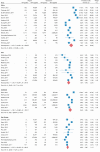HIV prevalence ratio of international migrants compared to their native-born counterparts: A systematic review and meta-analysis
- PMID: 36147629
- PMCID: PMC9486043
- DOI: 10.1016/j.eclinm.2022.101661
HIV prevalence ratio of international migrants compared to their native-born counterparts: A systematic review and meta-analysis
Abstract
Background: People on the move, including international migrants, may face health inequities that expose them to a higher risk for HIV than native-born populations. We conducted a systematic review to calculate the HIV prevalence ratio of international migrants compared with native-born populations.
Methods: We searched five databases between January 2010 and March 2022. Using random-effects meta-analysis, we calculated the pooled HIV prevalence ratios (PR) by comparing the HIV prevalence of migrants with native-born populations. Our research protocol is registered in the International prospective register of systematic reviews (PROSPERO, CRD42021250867).
Findings: In total, 5,121 studies were screened, and 38 were included in the final analysis: 7,121,699 migrants and more than 270 million natives were included in the analysis. The pooled PR for any foreign-born migrants was 1·70 (95% CI 1·11 - 2·61, I2 =99·67%, n = 33 studies), refugees was 2·37 (95% CI 0·33-16·99, I2 =99·5%, n = 5), undocumented people was 3·98 (95% CI 0·11-143·01, I2 =94·6%, n = 3), whilst asylum seekers was 54·79 (95% CI 17·23-174·23, I2 =90·2%, n = 2). Meta-regression revealed that population type (adjusted R-squared 11.5%), region of origin (11.3%) and migrant type (10.8%) accounted for heterogeneity more than country-income (2.4%) and study setting (2.3%).
Interpretation: Although it was not possible to assess if HIV infection occurred in the country of origin or destination, the HIV prevalence ratio was higher among migrants than in native-born populations. Inclusive health policies and strategies for delivering HIV testing, prevention and treatment services for migrant populations tailored to their needs are urgently needed.
Funding: J.J.O. and E.P.F.C. are supported by the Australian National Health and Medical Research Council (NHMRC) Emerging Leader Fellowship (GNT1193955 and GNT1172873, respectively).
Keywords: HIV; asylum seekers; migrants; native-born; people on the move; prevalence; refugees.
© 2022 Published by Elsevier Ltd.
Conflict of interest statement
We declare no competing interests.
Figures







References
-
- UNAIDS . In: Fast-Track: Ending the AIDS Epidemic by 2030. UNAIDS, editor. UNAIDS; Geneva, Switzerland: 2014. https://www.unaids.org/en/resources/documents/2014/JC2686_WAD2014 report
-
- UNAIDS . UNAIDS; Geneva, Switzerland: 2021. Global HIV & AIDS Statistics — Fact Sheet.https://www.unaids.org/en/resources/fact-sheet
-
- UNAIDS . UNAIDS; Geneva, Switzerland: 2015. UNAIDS 2016-2021 Strategy | On the Fast-Track to End AIDS.https://www.unaids.org/en/resources/documents/2015/UNAIDS_PCB37_15-18
Grants and funding
LinkOut - more resources
Full Text Sources
Research Materials

